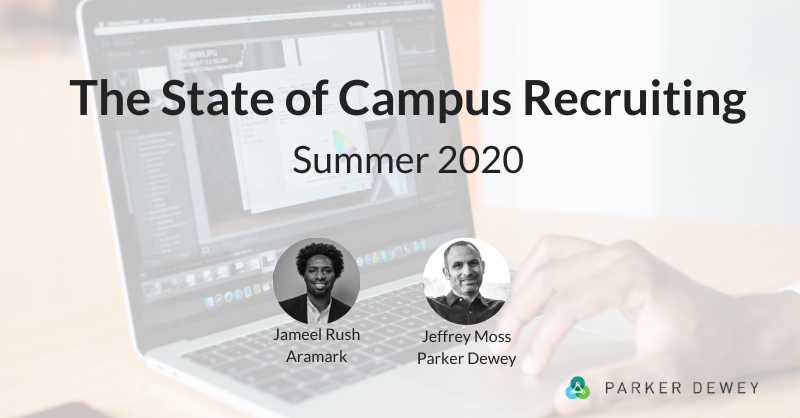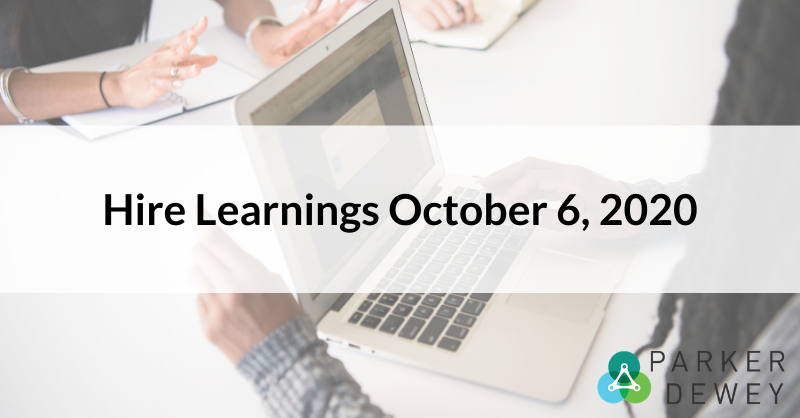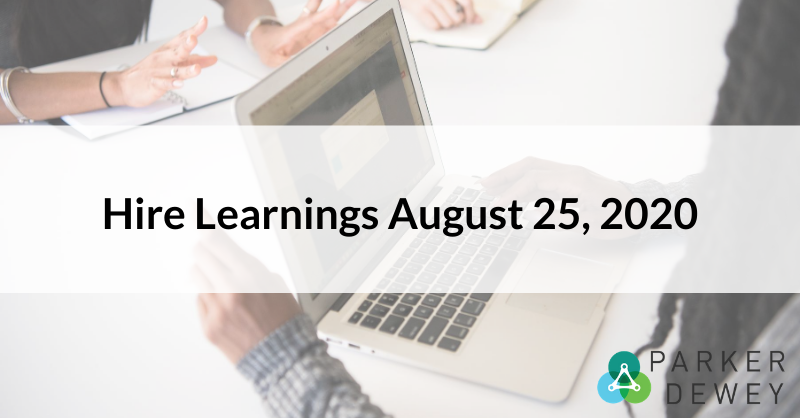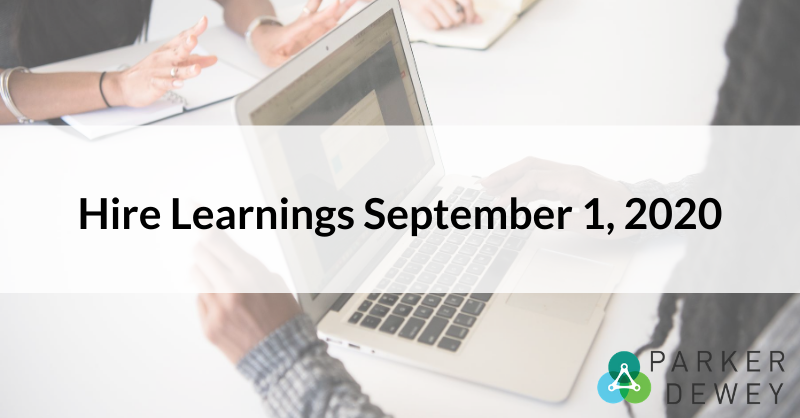
COVID-19, Diversity, and Fall Recruiting
On June 25, 2020, CEO of Parker Dewey, Jeffrey Moss, and Chief Diversity Officer of Aramark, Jameel Rush, had a live conversation about the state of campus recruiting in regards to COVID-19, diversity, and what to expect for this fall.
Here’s a synopsis of the conversation including some of the key takeaways and quotes from Jameel and Jeffrey. In addition, the replay is now available on-demand.
Campus recruiting post-COVID-19
Jeffrey: Recruiters anticipate that they probably won’t be back on campus this fall. What are recruiters worried about and what are some of the big concerns?
Jameel: “The way you create a presence on campus is to consistently be there to build these relationships. This year will be uncharted territory for both campuses and employees.”
One of the main concerns about moving forward is that companies are still trying to figure out what the future looks like. No one knows what next year is going to look like as far as the development of the pandemic, so this impacts the way recruiters and campuses can accurately predict anything. “For most organizations, they’re blindly throwing darts.”
Part of this is that campuses are still trying to figure out what they are going to do this fall. Some schools will be open while others are not, with many still deciding whether a fall semester will be virtual or partially on-campus. “Lots of things are up in the air and companies don’t know how to engage yet. With so many unknowns, you don’t want to be caught not knowing what to do,” leading to many companies stuck in a wait-and-see mode.
Jeffrey: Are there silver linings to this situation? Are there new opportunities that never existed since you can’t be on campus? Can it break down geographical limitations, focus schools, etc?
Jameel: “Now more students will be able to access the programmatic [recruiting] content because everything is virtual.” The personal connection part of the job hunt has always been important in the process. Companies are pivoting toward professional development programming for students to create more access that they haven’t had before, especially due to geographic limits.
Jeffrey: Does this start to level the playing field for fancy pedigree students versus first-generation students?
Jameel: In general, for this to happen “recruiting teams have to be intentional with it.” Being intentional in leveling the playing field as an employer means those things will be reinforced to provide content and access to a diverse community. “Going virtual doesn’t mean that all of this will come together [on its own].” There has to be a directed effort for this leveling to happen within these communities.
Jeffrey: If it's no longer hiring managers and preconceived notions based on what they think a candidate should look like – does this create a catalyst to start to break down some of those barriers?
Jameel: As a recruiter, you’re going to engage hiring managers about what the changes look like regardless. “This is the opportunity for you to educate managers on what objectives you have around representation and build that into the recruiting process as you’re telling them about what needs to happen to adjust.” As an HR professional, you really have to be much more intentional about it as you educate managers about the work that needs to happen to break these barriers down.
A lot of what is taking place in HR departments right now is professionals trying to help the manager understand that candidates don’t need a certain GPA or major to do the role. Many have started using the experiential recruiting approach where they’re giving managers opportunities to engage with candidates to actually see their work product and it’s becoming part of the manager retraining.
“And that’s why losing the internship pool is such a detriment for organizations. Interns are your known commodity; they’ve worked with you, they get your business and not being able to pull from that list becomes an obstacle.” Companies that had to cancel internships and did not transition to virtual or short-term opportunities are at risk in the long-run when it comes to keeping their talent pipeline filled.
Jeffrey: Students are being bombarded with emails from companies and organizations that have brand recognition. How do you get through the noise?
Jameel: “It’s really about consistency and building relationships on campus.” If your message comes from career services or a faculty member, it supplements and supports the dynamic of that relationship. You have to be the resource and build a good relationship with those key individuals on campus. Create a fair and authentic give and take relationships with them, and they’ll help you get through the noise.
You can also generate ambassadors through the campus organizations. For example, mock interviews provide content that adds value to the students and it can become a catalyst to form mentoring relationships. Doing this lowers the preconceived risks for diverse or underrepresented talent pools since your key connections on campus have existing relationships with these students already.
Talking about Diversity & Inclusion
Jeffrey: What are some things you’re seeing as far as integrating recruiting for D&I?
Jameel: “It’s really important to understand that diversity and inclusion are two very separate topics.” There is the diversity of the workforce or the diversity of the talent versus inclusion which is within a company’s culture and in the policies and procedures that help to ensure fairness and equality of opportunity for everyone’s voice to be heard.
Think about what programs you already have within your organization that give exposure to senior leaders for your diverse communities. Individuals tend to gather toward those that are like them. “So if your senior leadership isn’t diverse, how do you make sure that they will be intentional about mentoring and sponsoring that high potential diverse talent within the organization?”
Also think about the programs you have in place that create community as well, both for those in communities and for allies that want to be part of the solution. It has become imperative that if you’re thinking about a diversity strategy, you have to be thinking about the inclusion strategy as well.
Your managers should also understand the business impact. We don’t value diversity and inclusion just because it’s the right thing to do – which of course is at the heart of it–but also, there are significant business impacts associated with doing this work well.” Revenue outcomes, performance outcomes, and level of engagement are higher in organizations that drive diversity and inclusion.
Jeffrey: Is it more or less difficult when work is remote?
Jameel: It may be too soon to tell since everyone is in crisis management mode as many companies are heavily impacted. However, companies know that if they’re not being intentional about getting exposure to the diverse communities, they’re getting left behind.
“Make sure that you’re intentional about creating space for leadership to see and know the value that your diverse team members are bringing to the table.” For the long-term, he believes part of this strategy will need to involve thinking about how employers are sponsoring and mentoring people who do not look like the vast majority of their workforce.
Virtual Recruiting
Jeffrey: What strategies is Aramark using for virtual recruiting that are going well or not and what do you expect to see continue when we come out of the other side of the pandemic?
Jameel: “We’re tapping into what other organizations are doing, so we’re using video interviewing, we’ll talk to campuses about what virtual job fairs look like and virtual career fairs and how to utilize those, we’re looking at ways to organize students and continue to provide really strong career development activities on campus, and I think a lot of those will continue because we have a large dispersed workforce.”
Our team is also paying attention to what the new success measures are. New guidelines around diversity and inclusion this year may include representation in hires, who is being hired off campuses, and how many interviews are being converted to full-time. This baseline will look different than what it has been in the past.
Aramark also continues its internship program this summer, though not nearly as many interns as normal due to closures nationwide.
Jeffrey: What are you hearing or thinking around virtual career fairs?
Jameel: While this is an avenue that employers will be tapping into more broadly this fall, there is disadvantage to equity with internet bandwidth and high-speed access. “You just have to be aware of who and where are the communities that have been impacted and then what are the other things you’re going to be doing to supplement to make sure you still get access to the best talent in these places.”.
Jeffrey: For companies that boast a strong employee culture, how can they authentically convey the importance of diversity and inclusion in a virtual environment?
Jameel: Ambassadors and people relevant to the student audience are critical in this instance. A message from an ambassador or an alum can be more effective. For example, if they can go to the students and express that they were in their shoes and how your organization has helped them grow, it is more authentic and representative of them. “Highlighting success stories, in particular ones that are relevant to the students on campus, goes a long way in that value proposition.”
Jeffrey: What are the insights you’re seeing from the students this year?
Jameel: “They’re remarkably strong-willed.” Students and recent graduates this year are being extremely creative about how to best tap into this time to be ready for when things start turning around. Some don’t know what to expect and are in a limbo waiting it out until employers start hiring again. Others are avidly making connections and networking so that they’re ready when the time comes and they will be top of mind to get called back or interviewed.
Innovation drives the way forward
Jeffrey: What are some of the innovations that are taking place right now?
Jameel: “Many organizations are hyper-focused on the social unrest that is going on right now and how they are responding.” Companies are forced to focus on this issue in a different way and think about what they are doing to serve Black and African-American communities. There is a movement to help disband systemic racism whether it’s individually, within their teams, or with long-term commitments.
Employers and consumers alike are holding companies and organizations accountable. Their stakeholders are asking questions so that words are not being put out without an actionable follow-through. “I think what we see now is the pivot to here’s what I’m going to do about it and here’s how we’re actually going to make sure that we’re part of the solution.”
Jeffrey: How can we make sure that we don’t lose this momentum when people return to the workplace?
Jameel: This work is going to involve every individual as we each have a role to play. It will need to be more than the diversity office driving changes. We can ask leaders within our companies questions around their action steps, policies, procedures, and even bring up the awareness in areas where inequality still resides. “When we individually start to hold organizations accountable and hold ourselves accountable, that’s how it remains consistent. When you put it on someone else to do it for you then it’s hard.” Diversity and inclusion is not a department that can exist in a vacuum.
Related Reading: How Micro-Internships Can Bring Diversity, New Perspectives, and Talent to Employers






